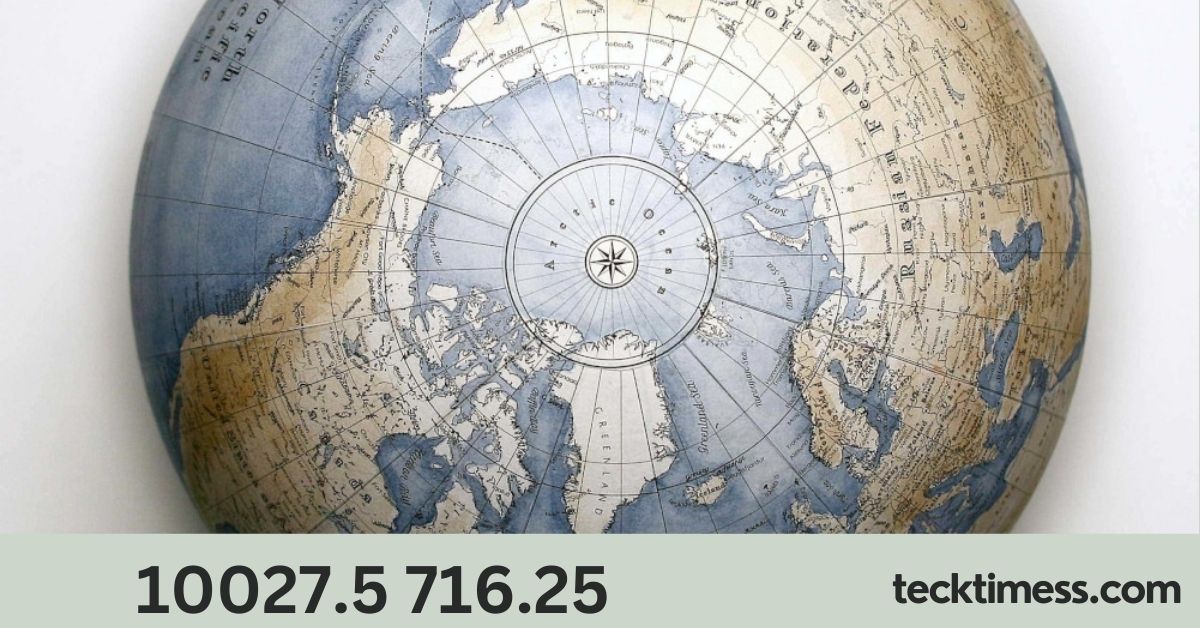When you see the numbers “10027.5 716.25,” you might wonder what they represent. These numbers are not just random figures; they are geographical coordinates, a way to pinpoint an exact location on the earth’s surface. Understanding how these coordinates work is essential for navigation, mapping, and a variety of other applications. This article will explore the meaning behind “10027.5 716.25,” explain how geographical coordinates function, and delve into their real-world applications. By the end of this article, you’ll have a thorough understanding of what these numbers mean and how they are used globally.
What Are Geographical Coordinates?
Geographical coordinates are a system used to define the position of a point on the Earth’s surface. The system is based on a set of imaginary lines—latitude and longitude—that encircle the globe.
- Latitude measures how far north or south a point is from the Equator.
- Longitude measures how far east or west a point is from the Prime Meridian, which runs through Greenwich, England.
The coordinates are typically expressed in degrees, minutes, and seconds, but can also be represented in decimal form. For instance, the coordinates 10027.5 716.25 use decimal degrees to pinpoint a specific location.
Breaking Down 10027.5 716.25: Latitude and Longitude
The coordinates 10027.5 716.25 represent two separate values: latitude and longitude. To understand these better, let’s break them down:
- Latitude (10027.5): This number indicates the location’s distance north or south of the Equator. Since latitude values range from -90 to 90 degrees, a value of 10027.5 would theoretically lie in the northern hemisphere. However, this specific number needs further context, as it appears to exceed the typical latitude range. This might suggest a specific format or a different context in geographical databases.
- Longitude (716.25): This number specifies the location’s distance east or west of the Prime Meridian. Longitudes range from -180 to 180 degrees. Similar to the latitude, a longitude value of 716.25 seems to exceed the typical range, suggesting it might be part of a specialized coordinate system or a different interpretation is needed.
The Importance of Understanding Coordinates
Understanding geographical coordinates like 10027.5 716.25 is crucial for several reasons:
- Navigation: GPS devices rely on coordinates to provide accurate navigation information.
- Mapping: Maps use coordinates to represent locations.
- Emergency Response: Coordinates help in locating people during emergencies or natural disasters.
- Scientific Research: Geographical data is vital in fields like geology, archaeology, and meteorology.
Interpreting Unusual Coordinates
The coordinates 10027.5 716.25 don’t fit within the standard ranges of latitude and longitude. This could imply several things:
- Different Geographical Systems: Some specialized fields or databases might use modified coordinate systems that expand beyond the typical -90 to 90 and -180 to 180 ranges.
- Data Encoding or Conversion: Sometimes, coordinates might be encoded in a specific format or need conversion to standard formats for proper interpretation.
- Error or Typo: There is also the possibility that these coordinates could contain errors or represent a typo, which is common in manually recorded data.
Real-World Applications of Geographical Coordinates
Geographical coordinates like 10027.5 716.25 are used in various real-world applications:
- GPS and Navigation Systems: GPS devices use coordinates to provide users with precise location information. Understanding how to read and interpret these coordinates is essential for anyone using a GPS for navigation.
- Cartography and Mapping: Maps use geographical coordinates to represent different locations. Modern digital mapping services like Google Maps rely on these coordinates to provide accurate location data.
- Search and Rescue Operations: In emergency situations, rescuers use coordinates to find people in need. Whether it’s a lost hiker or a ship in distress, precise coordinates can mean the difference between life and death.
- Scientific Research and Environmental Studies: Researchers in fields like geology, archaeology, and environmental science use geographical coordinates to locate areas of interest, study natural phenomena, or conduct field research.
- Aviation and Maritime Navigation: Pilots and ship captains use coordinates to navigate across oceans and continents. Understanding these coordinates ensures safe and efficient travel.
The Science Behind Geographical Coordinates
To fully appreciate the significance of “10027.5 716.25,” it’s important to understand the scientific principles behind geographical coordinates. The Earth is not a perfect sphere but rather an oblate spheroid, meaning it’s slightly flattened at the poles and bulging at the Equator. This shape affects how coordinates are calculated and represented.
Latitude: Measuring North and South
Latitude lines run horizontally around the Earth and are measured in degrees from the Equator. The Equator is 0 degrees latitude, the North Pole is 90 degrees north, and the South Pole is 90 degrees south. When coordinates exceed these ranges, it typically indicates a different context or a specific scientific notation.
Longitude: Measuring East and West
Longitude lines run vertically from the North Pole to the South Pole. The Prime Meridian, located at Greenwich, England, is 0 degrees longitude. Longitudes range from 0 to 180 degrees east and 0 to 180 degrees west. A longitude value of 716.25 exceeds this range, suggesting an alternative interpretation or an error.
How Are Coordinates Used in Modern Technology?
Geographical coordinates are fundamental in modern technology, particularly in:
- Satellite Navigation Systems: Satellites orbiting the Earth constantly send signals to GPS devices, which use coordinates to determine the user’s exact location.
- Geographic Information Systems (GIS): GIS technology uses coordinates to analyze and visualize spatial data, crucial for urban planning, environmental monitoring, and disaster management.
- Augmented Reality (AR): AR applications use real-world coordinates to overlay digital information onto the physical world, enhancing user experiences in navigation, gaming, and education.
Common Misinterpretations of Geographical Coordinates
While geographical coordinates are incredibly useful, they are also prone to misinterpretation:
- Incorrect Formatting: Mixing up latitude and longitude or misplacing a decimal point can lead to vastly different locations.
- Misunderstanding the Coordinate System: Not all coordinates use the same system. For example, the Military Grid Reference System (MGRS) is different from the standard latitude and longitude system.
- Ignoring Datum Shifts: Different maps use different datums (reference points), which can cause shifts in coordinates. The World Geodetic System 1984 (WGS84) is the most widely used datum today.
How to Convert and Use Geographical Coordinates
If you have coordinates like 10027.5 716.25 and want to use them practically, you might need to convert them to a standard format:
- Converting to Degrees, Minutes, and Seconds: This format is widely used in navigation. To convert decimal degrees to degrees, minutes, and seconds:
- The whole number part represents the degrees.
- Multiply the decimal part by 60 to get minutes.
- Multiply the remaining decimal by 60 to get seconds.
- Using Mapping Software: Tools like Google Earth or GIS software can input coordinates and provide a visual representation of the location.
- Adjusting for Different Datum: Ensure your coordinates are using the correct datum, or convert them to WGS84 if they aren’t.
FAQs About Geographical Coordinates 10027.5 716.25
What do the coordinates 10027.5 716.25 represent?
These coordinates represent a specific point on the Earth’s surface, using latitude and longitude. However, the values provided exceed the standard ranges, which might indicate a specialized use or a need for conversion to standard formats.
How are geographical coordinates used in everyday life?
They are used in navigation (GPS systems), mapping (digital and paper maps), emergency response (search and rescue), and scientific research.
Why do the values 10027.5 716.25 exceed normal latitude and longitude ranges?
These values likely use a different coordinate system or represent data that requires conversion. The standard ranges are -90 to 90 for latitude and -180 to 180 for longitude.
Can I input 10027.5 716.25 directly into a GPS?
You might need to convert these coordinates to a standard format before using them in a GPS device.
How do I convert unusual coordinates like 10027.5 716.25 to standard latitude and longitude?
You can use online converters or GIS software to interpret and convert these coordinates to a standard format.
Are there different types of geographical coordinates?
Yes, there are several systems, including latitude/longitude, UTM (Universal Transverse Mercator), and MGRS (Military Grid Reference System).
What is the difference between latitude and longitude?
Latitude measures north-south position relative to the Equator, while longitude measures east-west position relative to the Prime Meridian.
Conclusion
Understanding geographical coordinates like 10027.5 716.25 is crucial for navigation, mapping, and a variety of scientific applications. While these specific coordinates may not fit within the standard ranges of latitude and longitude, they still represent an important concept in geographical science. By understanding how to interpret, use, and convert these coordinates, you can better appreciate the role they play in our daily lives and the functioning of global systems.





